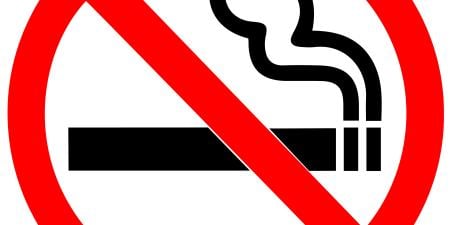Case
Mr. Benjamin was a middle-aged construction worker with a history of hypertension and congestive heart failure who sustained a vertebral fracture in a job-related accident. He was admitted to Rockport Hospital's orthopedic surgery ward in unstable condition for treatment of his injuries.
To complicate matters, Mr. Benjamin was angry at having had his cigarettes taken away upon admission, as required under Rockport's smoke-free policy. The policy, part of a wide antismoking initiative, banned smoking on hospital grounds and within 50 feet of hospital property, eliminating even the possibility of walking outside for a cigarette break.
Mr. Benjamin was not doing well. He had smoked for more than 20 years and had no intention of stopping, despite counseling from his primary care physician. Though the hospital provided him with nicotine patches, he made it clear to the entire medical team including Dr. Thorman, the hospitalist in charge of his care, that he just wanted his cigarettes back. Over the course of 5 days, Mr. Benjamin grew extremely irritable and became short-tempered and uncooperative with the treating team. He threatened to leave the hospital against medical advice, refused to hold still for IVs or blood draws, and constantly tried to leave his hospital room despite being told to limit unnecessary movement.
Dr. Thorman realized that Mr. Benjamin's recovery would be greatly expedited if he were more compliant and wondered if Mr. Benjamin's outcome would improve if he were allowed to smoke during his stay. Dr. Thorman offered everything he could think of to help his patient relax—the nicotine patch, smoking-cessation therapy—all of which Mr. Benjamin refused.
Dr. Thorman knew that smoking was bad for his patient, particularly since he had heart disease, and that it was in direct violation of hospital rules. He recognized, however, the importance of speeding his patient's fracture recovery and allowing him to return to his family and work. Faced with this dilemma, he sought the assistance of the ethics consultant.
Commentary 1
Mr. Benjamin's situation raises ethical questions because of the effect cigarette smoke can have on the smoker and on bystanders exposed to second-hand smoke. The hospital policy banning smoking is similar to many societal regulations that restrict personal choice in the best interest of the individual and entire population. A comparable regulation is the law requiring individuals to obtain licenses to drive before entering public space behind the wheel of a motor vehicle—a regulation that must be followed in order to enjoy a privileged benefit. Mr. Benjamin's case invites us to consider:
- The effect of an individual's choice to smoke on his or her recovery from congestive heart failure, and the responsibility of the physician and society to hasten that recovery.
- The effect of an individual's choice to smoke on recovery time for orthopaedic injuries, and the responsibility of the physician and society to hasten that recovery.
- In-patient treatment of nicotine withdrawal where withdrawal symptoms may inhibit treatment of other conditions.
- Enforcement of hospital policies designed to protect the health of all patients and staff.
- Whether treatment for the primary acute injury can be delayed by a hospital policy.
We are not given specifics on how many cigarettes Mr. Benjamin smokes per day, but the extent of his withdrawal is not difficult to quantify. Enforcement of the hospital policy banned his cigarettes 5 days ago, and he is displaying physical signs of nicotine withdrawal [1]. Either physiologically or psychologically, he is suffering needlessly. The withdrawal symptoms can be treated with nicotine replacements, via patch, gum, or inhaler. It is the non-nicotine additives and particulates contained in inhaled tobacco products that are carcinogenic and inflammatory; in the short term, nicotine replacement could reduce Mr. Benjamin's symptoms, avoid harming him, and foster his recovery. Initiating replacement therapy is still a viable option if we can overcome Mr. Benjamin's initial resistance to it.
The first clinical ethics topic of concern is that Mr. Benjamin has congestive heart failure. Smoking accelerates the progression of coronary heart disease and diminishes the blood's capacity to carry oxygen to the body [2]. Smoking is also linked to congestive heart failure, and the number of diagnoses is elevated among smoking populations [3]. More smokers die from heart disease and plaque ruptures than cancer [2, 4, 5]. Even second-hand smoke increases incidences of acute coronary syndrome events [6]. Under no circumstances can a caregiver enhance the risk of an adverse condition unnecessarily. Dr. Thorman has not exhausted all of his options with regard to treating Mr. Benjamin.
The second clinical ethics concern is Mr. Benjamin's broken vertebrae from a work-related accident. The recommended rest and treatment is inhibited by his agitated state that is triggered by nicotine withdrawal. Most of the symptoms manifest between the third and fifth days of removal, and the majority of patients report that symptoms begin to improve after the first week. While Dr. Thorman may consider allowing Mr. Benjamin to smoke in order to gain his adherence to treatment, bone-healing time takes longer in smokers than in non-smokers [7]. The net effect of allowing Mr. Benjamin to smoke may not speed his short- or long-term recovery.
Nicotine withdrawal symptoms include cravings, irritability, inability to concentrate, insomnia, and fatigue. With nicotine replacement agents in patch, lozenge, or inhaler form available, and, given the evidence that second-hand smoke is harmful to anyone exposed, Mr. Benjamin should be prohibited from smoking. Medications are available to help reduce the physical symptoms of withdrawal, but they may not be effective due to Mr. Benjamin's unwillingness to quit at this time. It might be useful to ask some ex-smokers to talk to Mr. Benjamin, people whose congestive heart failure symptoms improved after they quit smoking by using a nicotine-replacement agent. Candidates can be found at hospitals with smoking-cessation clinics, and those who have succeeded in giving up smoking often want to help others.
Making an exception to allow Mr. Benjamin to smoke in the hospital would set an extremely poor precedent. If his withdrawal symptoms and resistance to nicotine replacement therapies do not lessen with time, another option is allowing him to sign out against medical advice. A doctor can arrange a home visit from a nurse or other professional who has no ethical opposition to individuals smoking at home. We firmly believe that a doctor should not prescribe or agree to a treatment that poses a direct hazard to other patients.
The job of a medical professional is to help Mr. Benjamin through education and symptom control such as nicotine-replacement therapy. This strategy also reinforces the role of a doctor as a teacher. Even if it is possible to isolate the patient so that tobacco use does not affect others, and to provide staff willing to be exposed to second-hand smoke, the no-smoking policy is an example of regulations that put societal benefit above individual preference. Returning to the driving analogy, everyone needs a license to drive a motor vehicle in a public space. Is it reasonable, safe, or helpful to make exceptions to that regulation?
References
-
Fielding JE, Husten CG, Eriksen MP. Tobacco: health effects and control. In: Maxcy KF, Rosenau MJ, Last JM, Wallace RB, Doebbling BN, eds. Public Health and Preventive Medicine. New York, NY: McGraw-Hill. 1998.
-
Centers for Disease Control and Prevention. Annual smoking-attributable mortality, years of potential life lost, and productivity losses—United States, 1997-2001. MMWR. 2005;54(25):625.
-
United States Public Health Service. Office of the Surgeon General. The health consequences of smoking: nicotine addiction: a report of the surgeon general. 1998. http://profiles.nlm.nih.gov/NN/B/B/Z/D/. Accessed August 25, 2008.
-
Centers for Disease Control and Prevention. 2001 surgeon general's report—women and smoking. 2001. http://www.cdc.gov/tobacco/sgr/sgr_forwomen/index.htm. Accessed August 25, 2008.
-
United States Public Health Service. Office of the Surgeon General. Reducing the health consequences of smoking: 25 years of progress: a report of the surgeon general: 1989 executive summary. http://profiles.nlm.nih.gov/NN/B/B/X/S/. Accessed August 25, 2008.
- Pell JP, Haw S, Cobbe S, et al. Smoke-free legislation and hospitalizations for acute coronary syndrome. N Engl J Med. 2008;359(5):482-491.
-
Centers for Disease Control and Prevention. 2004 surgeon general's report: the health consequences of smoking. 2004. http://www.cdc.gov/tobacco/data_statistics/sgr/sgr_s004/index.htm. Accessed August 25, 2008.



